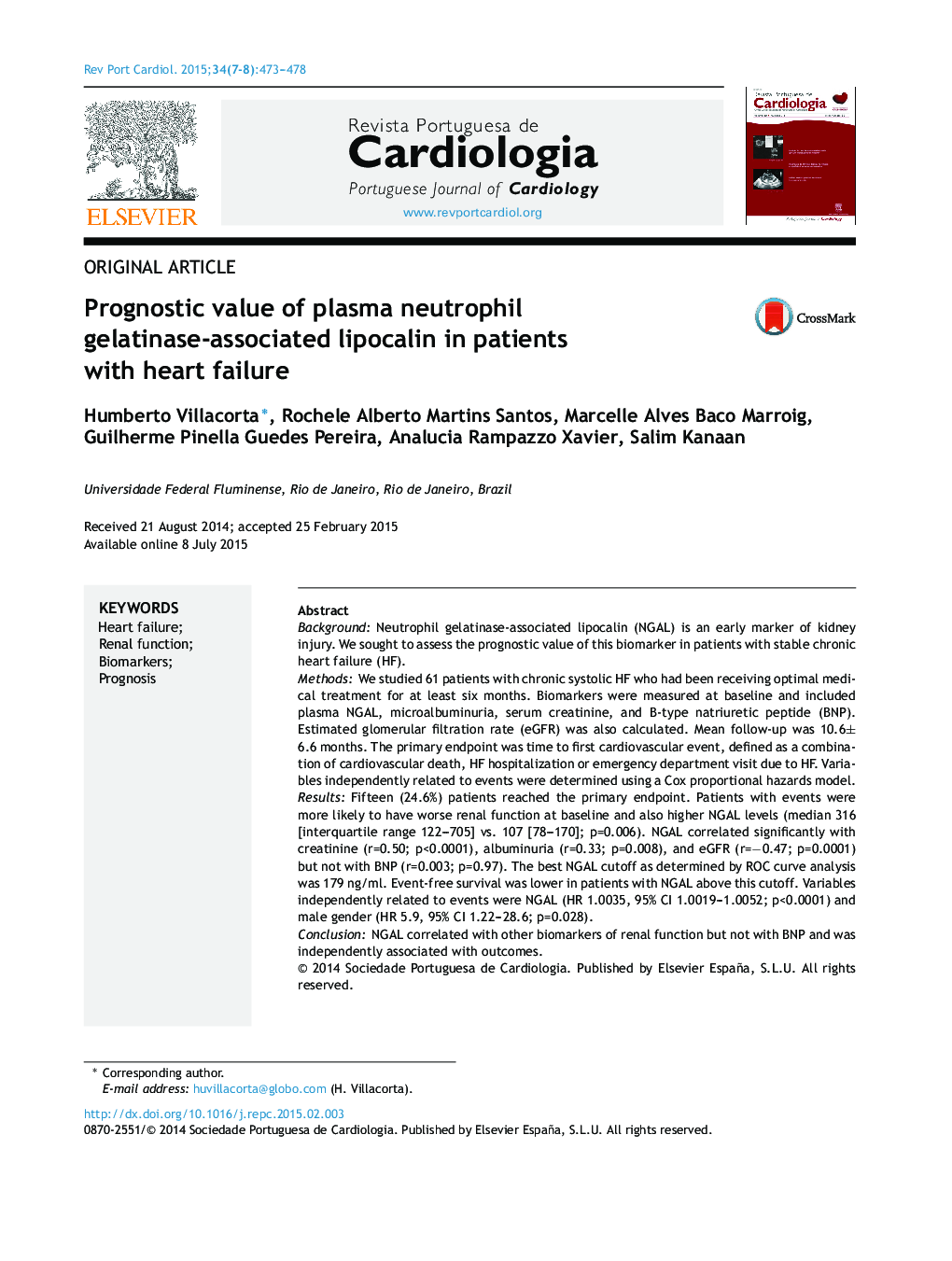| Article ID | Journal | Published Year | Pages | File Type |
|---|---|---|---|---|
| 1125721 | Revista Portuguesa de Cardiologia | 2015 | 6 Pages |
BackgroundNeutrophil gelatinase-associated lipocalin (NGAL) is an early marker of kidney injury. We sought to assess the prognostic value of this biomarker in patients with stable chronic heart failure (HF).MethodsWe studied 61 patients with chronic systolic HF who had been receiving optimal medical treatment for at least six months. Biomarkers were measured at baseline and included plasma NGAL, microalbuminuria, serum creatinine, and B-type natriuretic peptide (BNP). Estimated glomerular filtration rate (eGFR) was also calculated. Mean follow-up was 10.6±6.6 months. The primary endpoint was time to first cardiovascular event, defined as a combination of cardiovascular death, HF hospitalization or emergency department visit due to HF. Variables independently related to events were determined using a Cox proportional hazards model.ResultsFifteen (24.6%) patients reached the primary endpoint. Patients with events were more likely to have worse renal function at baseline and also higher NGAL levels (median 316 [interquartile range 122–705] vs. 107 [78–170]; p=0.006). NGAL correlated significantly with creatinine (r=0.50; p<0.0001), albuminuria (r=0.33; p=0.008), and eGFR (r=−0.47; p=0.0001) but not with BNP (r=0.003; p=0.97). The best NGAL cutoff as determined by ROC curve analysis was 179 ng/ml. Event-free survival was lower in patients with NGAL above this cutoff. Variables independently related to events were NGAL (HR 1.0035, 95% CI 1.0019–1.0052; p<0.0001) and male gender (HR 5.9, 95% CI 1.22–28.6; p=0.028).ConclusionNGAL correlated with other biomarkers of renal function but not with BNP and was independently associated with outcomes.
ResumoFundamentosA lipocalina associada a gelatinase de neutrófilos (NGAL) é um marcador precoce de injúria renal. O objectivo desse estudo foi avaliar o valor prognóstico desse biomarcador em pacientes com insuficiência cardíaca (IC) crônica estável.MétodosIncluídos 61 pacientes com IC por disfunção sistólica sob tratamento otimizado por no mínimo seis meses. Os biomarcadores foram dosados basalmente e incluíam NGAL plasmático, microalbuminúria, creatinina sérica e o peptídeo natriurético do tipo B (BNP). A taxa de filtração glomerular estimada (eTFG) também foi calculada. O seguimento médio foi de 10,6±6,6 meses. O desfecho primário foi o tempo até o primeiro evento, definido como uma combinação de morte cardiovascular, hospitalização por IC ou visita à sala de emergência por IC. A análise multivariada foi feita pelo Modelo de Riscos Proporcionais de Cox.ResultadosQuinze (24,6%) pacientes apresentaram um desfecho. Pacientes com desfecho apresentavam pior função renal e maiores níveis de NGAL (mediana 316 [variação interquartil de 122-705] versus 107 [78-170]; p=0,006). NGAL correlacionou-se significativamente com a creatinina (r=0,50, p<0,0001), albuminúria (r=0,33; p=0,008), e eTFG (r=−0,47; p=0,0001) mas não com BNP (r=0,003; p=0,97). O melhor corte de NGAL pela curva ROC foi 179 ng/mL. A sobrevida livre de eventos foi menor em pacientes com valores acima desse corte. As variáveis relacionadas de modo independente com eventos foram NGAL (razão de chances 1,0035, IC95% 1,0019-1,0052, p<0,0001) e sexo masculino (razão de chances 5,9, IC95% 1,22-28,6, p=0,028).ConclusãoNGAL correlacionou-se positivamente com marcadores tradicionais de função renal, mas não com o BNP e foi preditor independente de eventos.
